- Home
- Travel journal
- The Best Sicilian Foods
The Best Sicilian Foods
Sicily’s cuisine is a highlight for guests from all over the world: let's explore the best Sicilian foods in a journey that’s rich in flavours and features traditional ingredients and typical dishes.

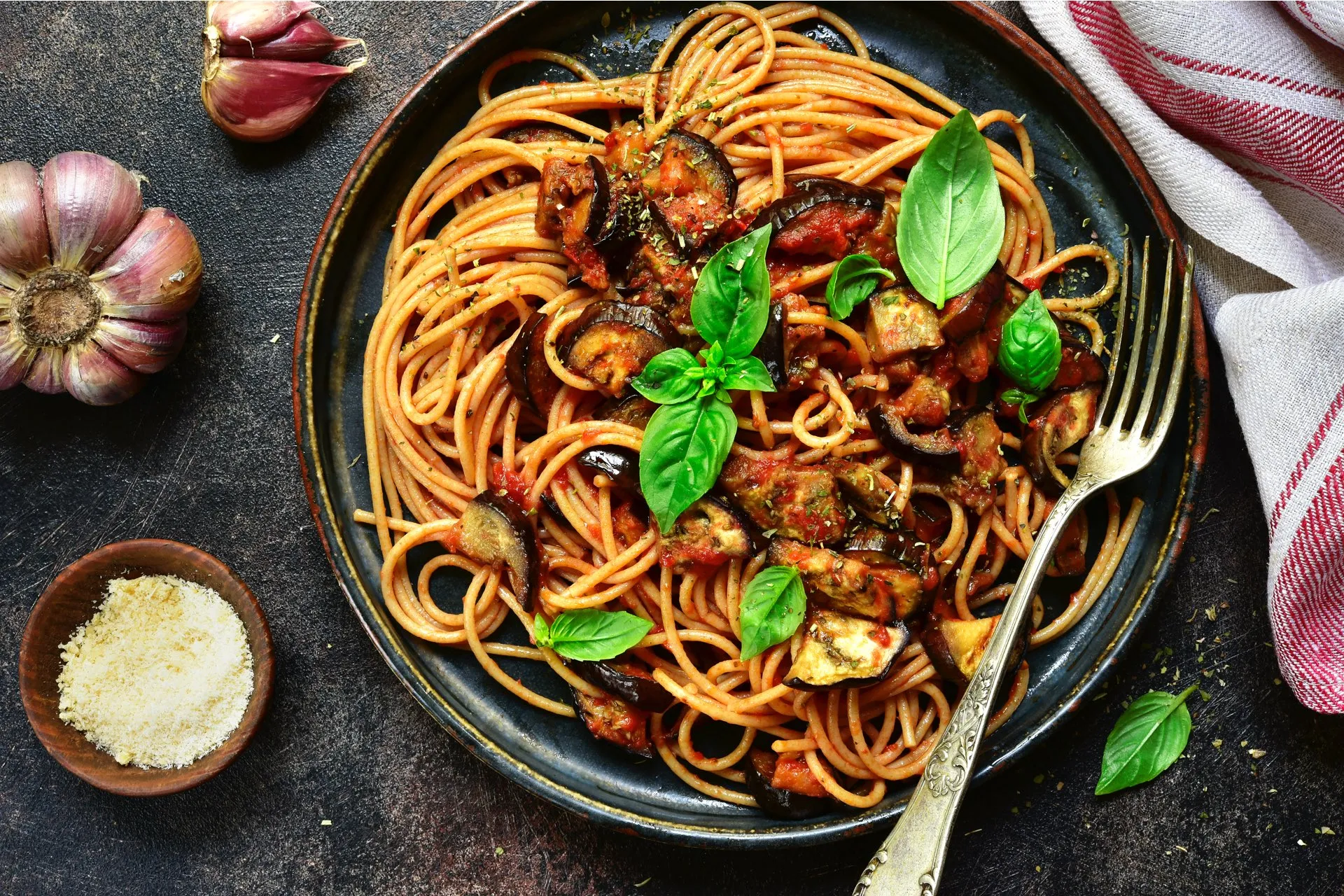
What to eat in Sicily: Sicilian flavours not to be missed
Sicilian cuisine is a charming mosaic of flavours, a refined symphony of influences that have blended over the centuries due to the various dominations the island has experienced. This cultural richness is reflected in every dish, making Sicilian gastronomy one of the most diverse and appreciated in Italy.
Street Food is the first captivating part of this culinary journey. The streets of Sicilian cities are a succession of scents and colours, where popular traditions come to life in delectable treats to savour while strolling around.
However, Sicilian cuisine doesn't end with Street Food. There are rich starters, often based on vegetables and fish, as well as first courses where pasta reigns with rich and savoury sauces. The main courses – whether meat or fish – tell the story of the island’s incredible variety, whilst desserts are a triumph of ricotta, almonds, chocolate, and citrus.
Sicilian gastronomy is a sensory journey through centuries of history, traditions, and cultural fusions. A culinary adventure rooted in a generous people who have turned cooking into a true art: let's begin this journey to discover the best foods of Sicily.
The Best Sicilian Street Food
Sicilian Street Food is one of the most authentic expressions of the island's popular cuisine. It brings together the history, culture, and traditions of a people who over the centuries have created extraordinary dishes using simple and sometimes humble ingredients. Walking through the markets and streets of Sicilian cities means immersing oneself in a true theatre of flavours, colours, and scents that captivate every visitor.
If you wish, you can experience one of our excellent culinary tours, Palermo Street Food Tour or Catania Street Food Tour.
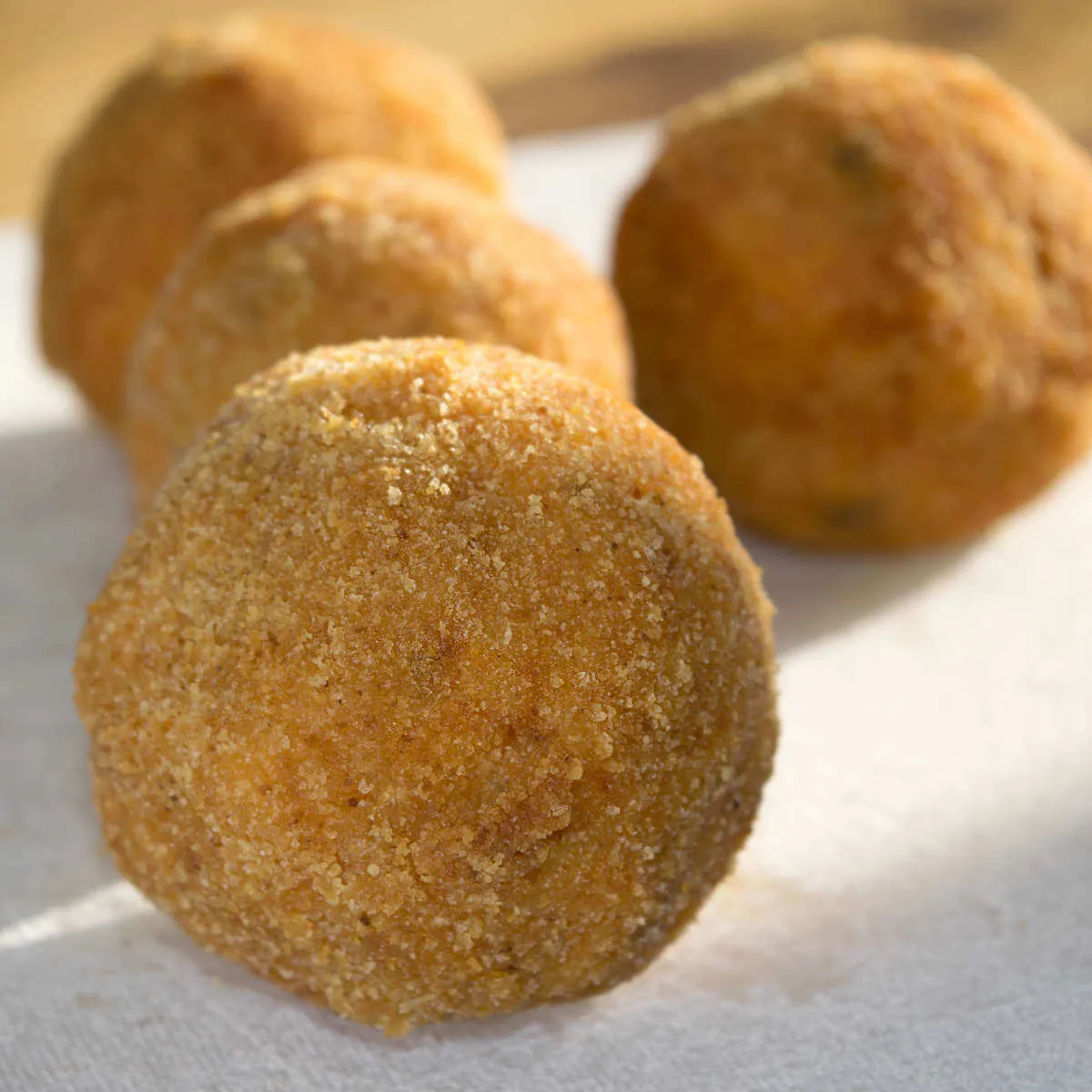
Arancine (or arancini)
Arancine (also called Arancini in some parts of the island, like in Catania) are one of the culinary icons of Sicily that are loved and well-known all over the world. These fried rice balls or cones have an ancient history and a tradition that sees them as protagonists in many festive occasions.
Arancine (whose name comes from the word "orange," recalling their shape and colour once fried) are made with rice – usually risotto rice like Arborio or Carnaroli – seasoned with saffron (which gives them their yellow colour) and filled by hand. The traditional filling is made with meat sauce, peas, and caciocavallo or mozzarella cheese, but there are numerous variations depending on the place and cook’s imagination: ham and mozzarella, spinach and cheese, mushrooms, just as a start. After being filled, arancini are closed and shaped into a ball or cone, dipped in beaten egg, and then breaded. Finally, they are fried in hot oil until golden and crispy.
They are a typical dish found practically everywhere in Sicily and are often consumed as a mid-morning snack or starter. However, due to their substantial nature, they can also be a quick lunch.
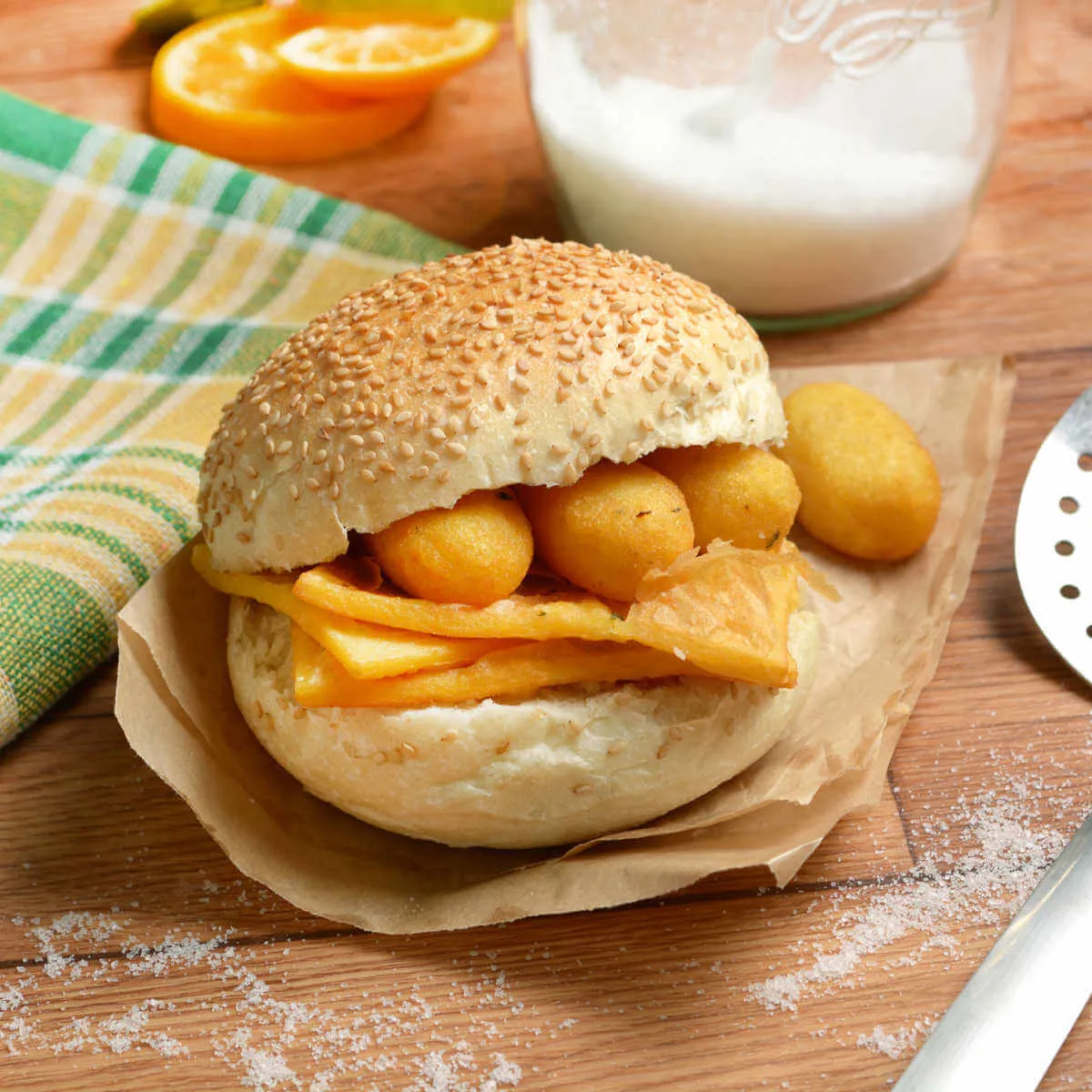
Pane, panelle and crocchè
Pane, panelle and crocchè are two of Sicilian Street Food’s most iconic foods. They are both loved for their unique combination of outer crispiness and inner softness.
Panelle, a classic of Palermo cuisine with deep historical roots, are fritters made from chickpea flour, water, salt, and parsley. Prepared by spreading a smooth batter on a flat surface, these fritters are cut into rectangles or diamonds and fried until they achieve a golden crispiness. Served inside a soft local roll called "moffoletta" or "vastedda", panelle offer an unforgettable taste experience, especially when enjoyed while strolling through the lively markets of Ballarò, Capo, and Vucciria in Palermo.
Crocchè, also known as potato croquettes, are also irresistible. These bite-sized treats are made with boiled and mashed potatoes, enriched with salt, pepper, grated cheese, and parsley, sometimes with the addition of nutmeg and egg. Shaped into oblong or cylindrical forms, they are then breaded and fried, creating a delicious crispy coating that encases a soft and flavourful centre, sometimes even with a melted core of caciocavallo, or a piece of ham.
For a moment of pure indulgence, try panelle and crocchè together!
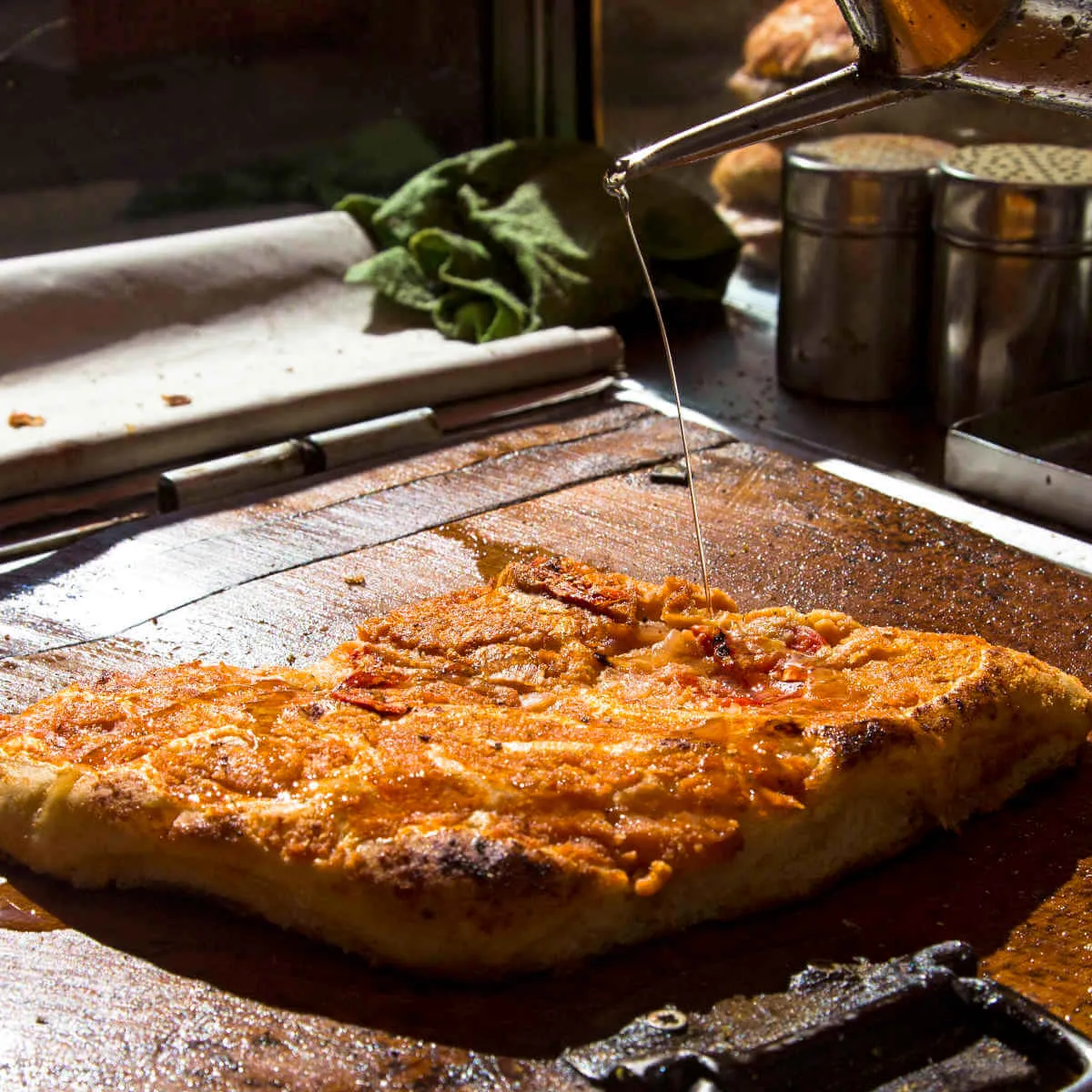
Sfincione
Sfincione (whose name comes from "sfincia," which means sponge in Sicilian dialect) is another gem of Palermo's gastronomy. It reflects the simplicity and richness of typical Sicilian flavours. At first glance, it may resemble a pizza, but both in preparation and in flavours, sfincione has unique characteristics.
The base of sfincione is a dough made of water, flour, yeast, and a bit of lard. The dough is left to rise until it achieves a soft and spongy consistency. The distinguishing feature of sfincione lies in its topping: a sauce made of stewed red onions, tomatoes, unsalted anchovies, oregano, and a generous sprinkling of caciocavallo, a typical Sicilian cheese. Everything is baked until the dough becomes golden and crispy on the bottom, while remaining soft in the centre. Olive oil and breadcrumbs are sprinkled on the top before baking, giving this dish an even more authentic flavour and a slightly crispy texture.
Where to eat it? Virtually everywhere! Sfincione is one of the most authentic expressions of Palermo's popular cuisine that encapsulates the genuine and traditional flavours of the island.
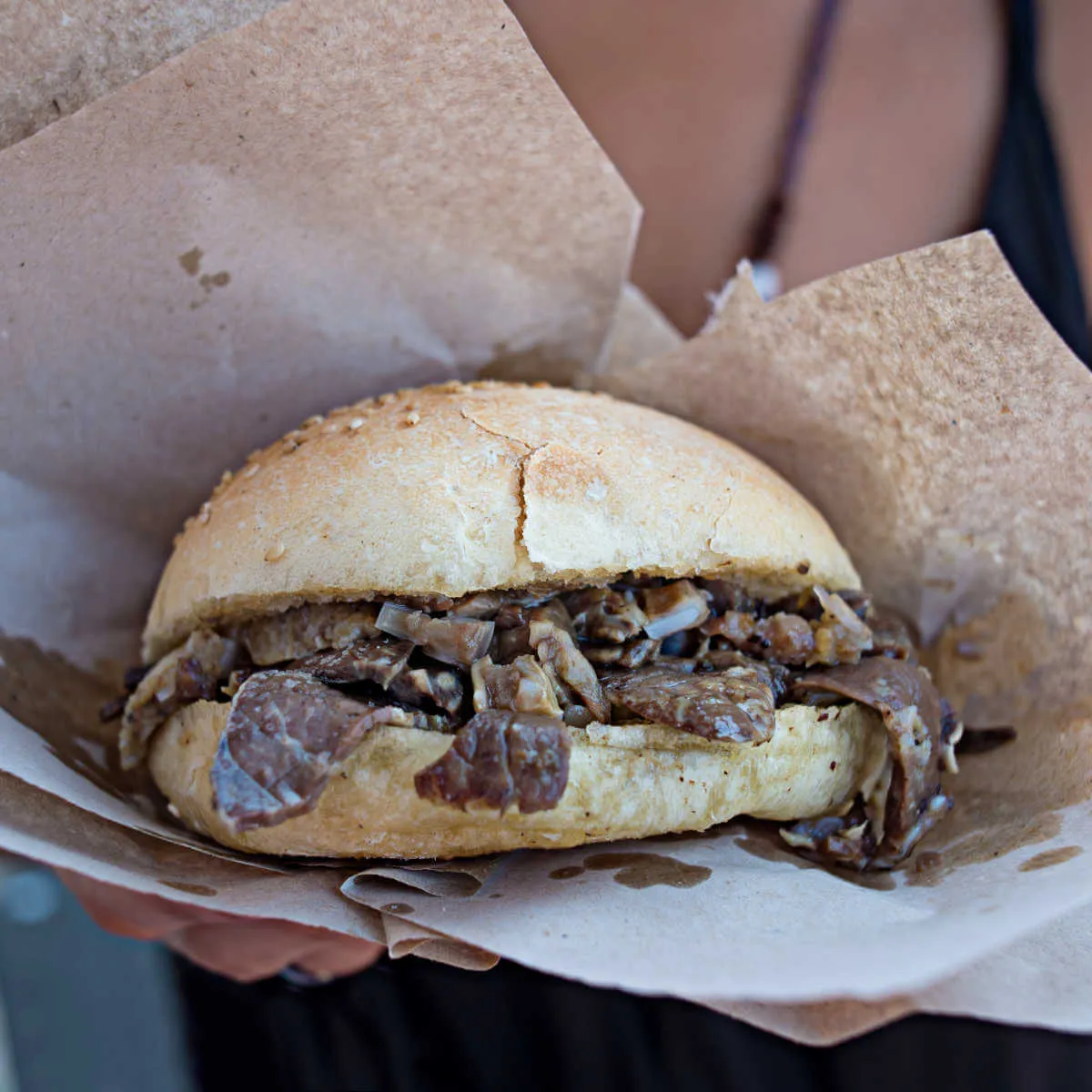
Pani ca' Meusa
Pani ca' Meusa, also known as "Pane con la Milza" is one of the most authentic specialties of Sicilian culinary tradition. This sandwich is the true essence of Sicilian Street Food and evokes the soul and history of Palermo.
The star of the show in this sandwich is veal spleen, which is boiled and then cooked in lard until it becomes tender. Sometimes, lungs are also added. The bread used is a type of soft roll called "vastedda," which is lightly toasted. Once ready, the bread is filled with plenty of cooked spleen, and everything is seasoned with a pinch of salt and lemon. There are two main versions: "schietta," with only spleen, or "maritata," where the spleen filling is accompanied by cheeses like ricotta or caciocavallo.
Pane con la Milza offers a contrast of flavours and textures: the soft bread perfectly complements the tender and flavourful spleen. Although the idea of eating spleen may seem unusual to many, the bold and distinctive taste of this sandwich wins over many palates, even the most discerning. A true gastronomic experience that every visitor to Sicily should try.
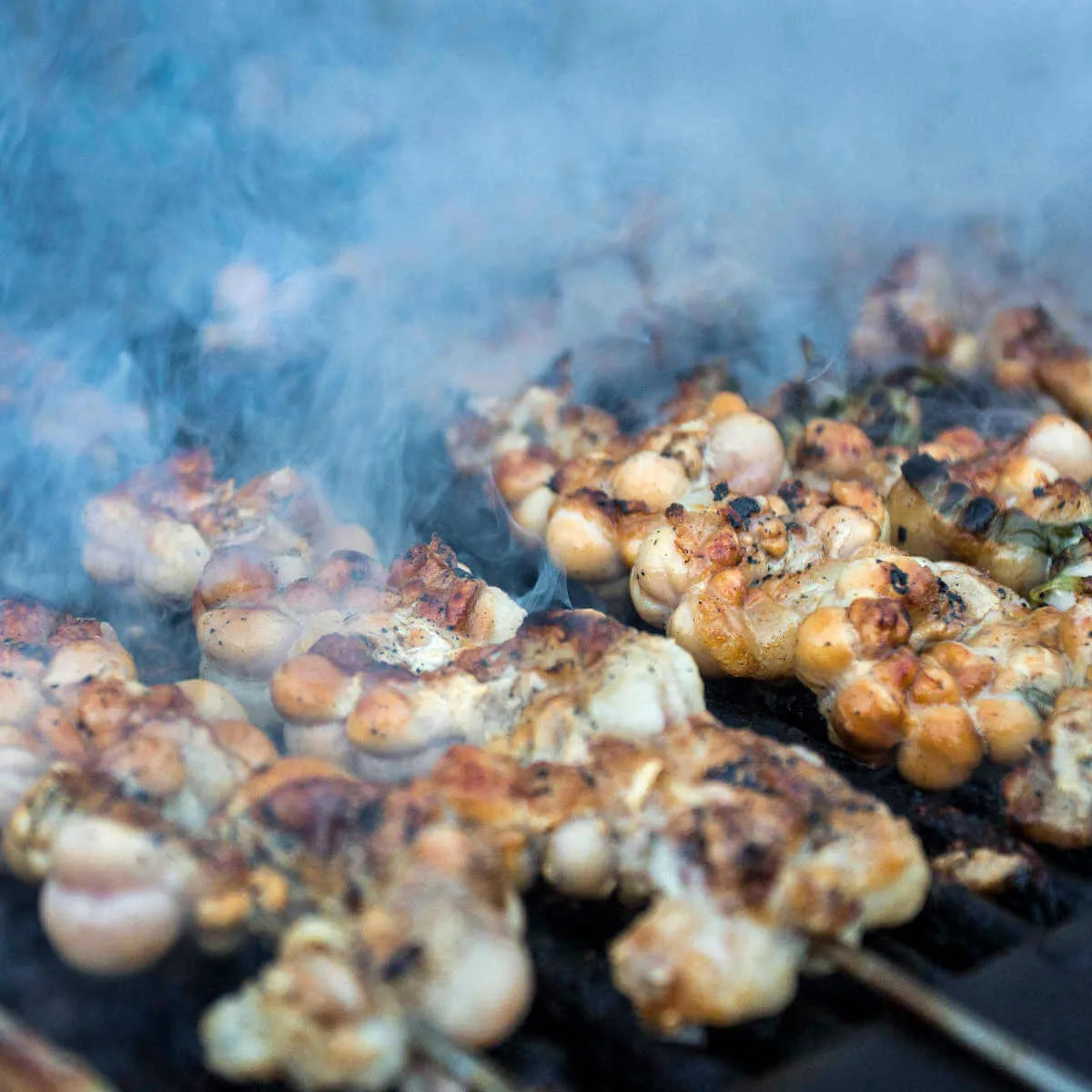
Stigghiola
Stigghiola are another cornerstone of traditional Palermo Street Food.
Stigghiola come from the gastronomic tradition of Palermo, and have long been considered a dish of the poor, as they use the less prized parts of the animal.
Stigghiola are made of lamb intestines, cleaned and washed carefully, which are then wrapped around bunches of parsley and spring onion. They are then skewered and grilled. As it cooks, stigghiola are often seasoned with salt and sometimes a bit of lemon. The grilling process gives the stigghiola a crispy and slightly smoky texture, while the inside remains tender and tasty, with the aroma of parsley or onion completing the whole experience.
Despite being a dish made of offal, its taste is delicate and not too strong, making it suitable even for those trying this specialty for the first time.
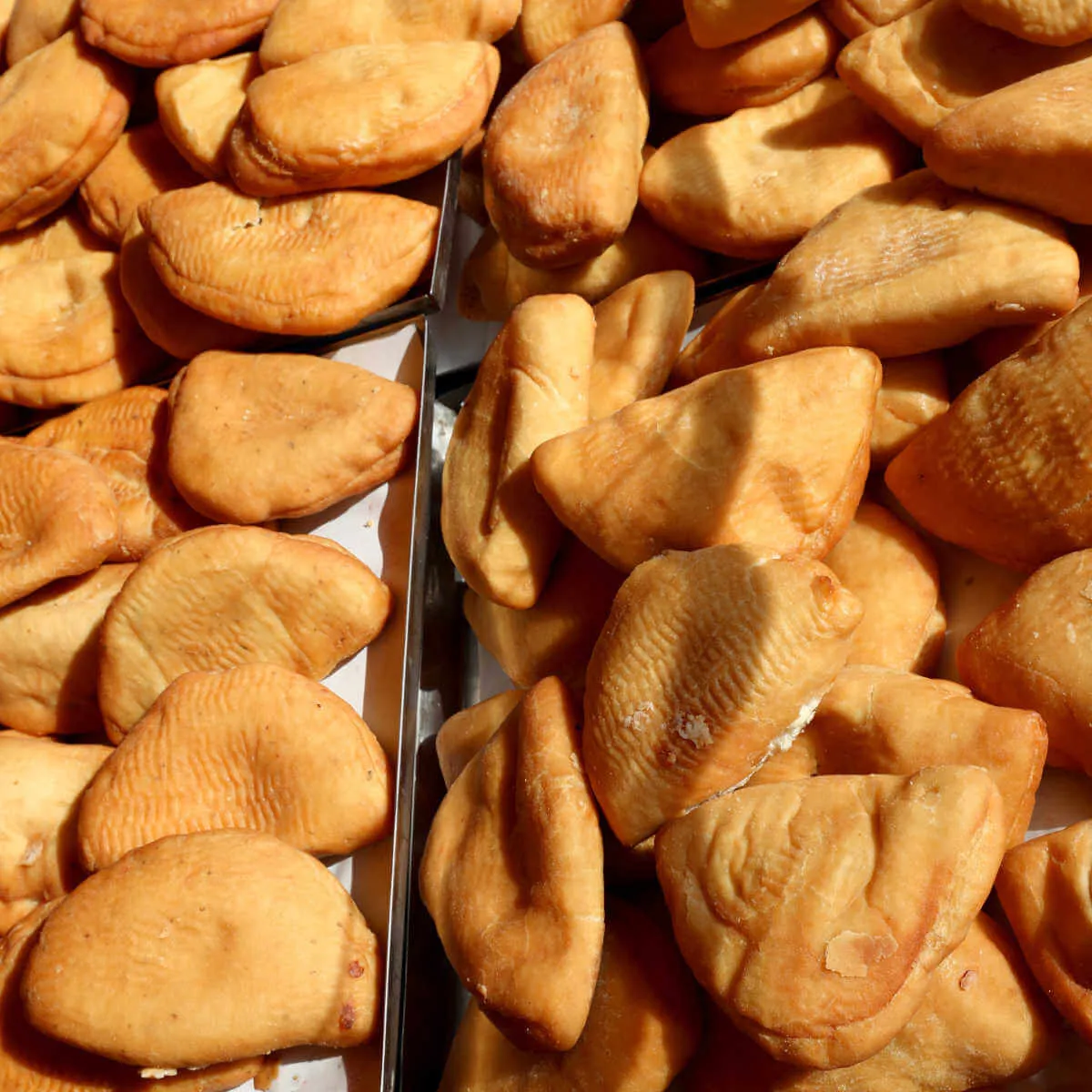
Cartocciata
Cartocciata catanese is one of the most beloved foods in the tradition of Sicilian Street Food, especially in Catania. This tasty snack has won the hearts and palates of both locals and tourists thanks to its rich flavour and handy convenience.
The cartocciata is a roll of filled puff pastry, similar to a savoury croissant or a calzone. The puff pastry is filled with various ingredients, the most traditional of which includes mozzarella, tomato, anchovies, olives, capers, and sometimes cooked ham or salami. After being filled, the puff pastry is rolled up and then baked until it is golden and crispy.
Typically consumed as a quick snack or a light meal, cartocciata is a very popular option for a lunch break or an afternoon snack. Thanks to its convenience, it's ideal to eat on the go, while strolling through the streets of Catania or exploring the city.
Particularly appreciated for its taste and versatility, you can find it practically everywhere.
Sicilian Antipasti to Try
Antipasti in Sicily are a true gastronomic ritual that kick off the pleasures of a meal. These starters, often colourful and always tasty, embody the richness and variety of Sicilian cuisine, blending Greek, Arab, Spanish, and Italian influences into unique and delightful combinations.
Let's explore some of the best Sicilian antipasti.
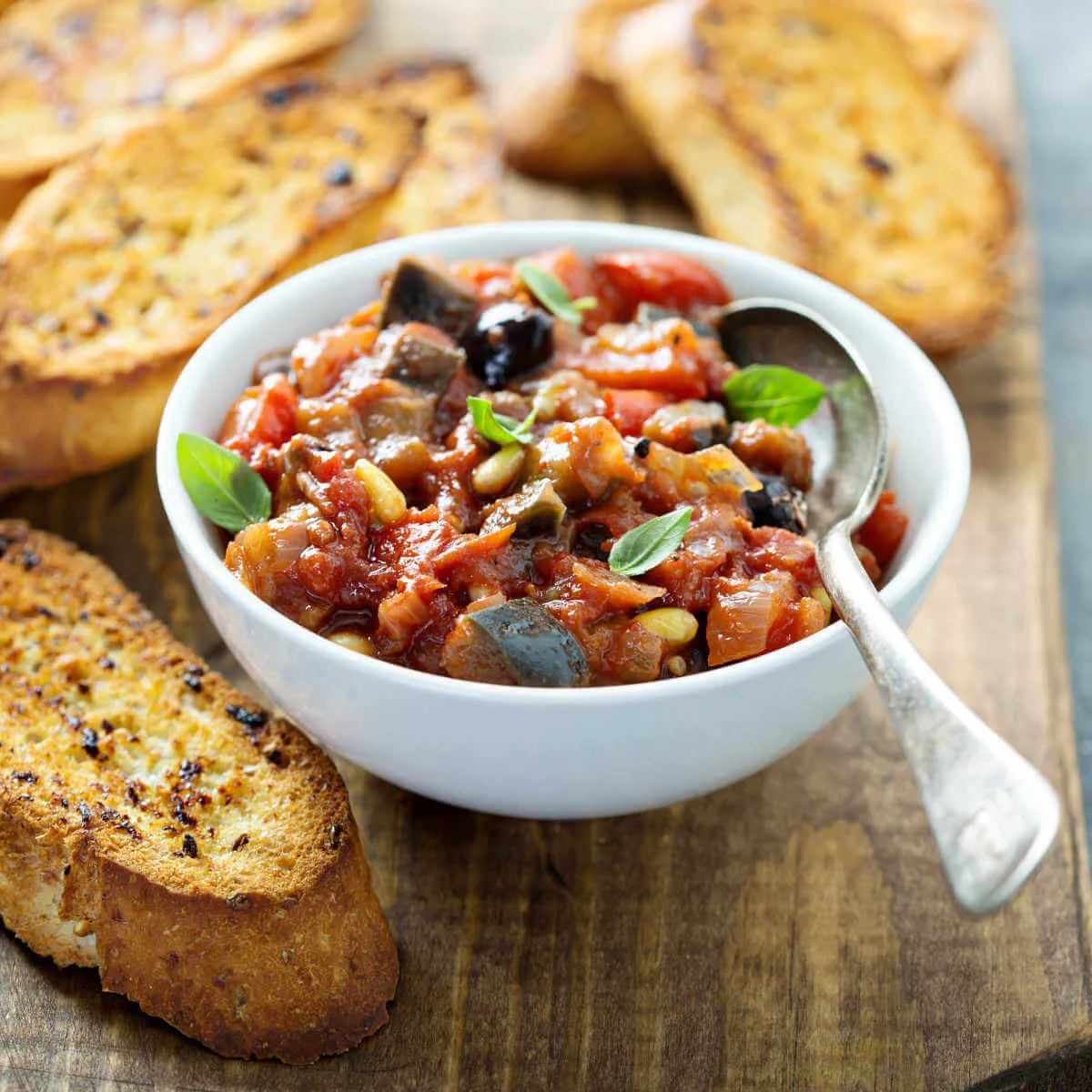
Caponata
Caponata is one of Sicily's most famous recipes. Despite its humble origins, it represents the sophistication of Sicilian cuisine, characterised by a unique balance of sweet and savoury flavours.
The heart of caponata is aubergine. This vegetable is diced and fried until soft and golden. The fried aubergine is then sautéed with tomatoes, onions, celery, green olives, capers. What really sets caponata apart is its sweet and sour sauce: a combination of vinegar and sugar (or sometimes honey) added at the end of cooking. This sauce gives the dish its characteristic contrasting flavour, with sweet notes balancing the saltiness of olives and capers.
There are many variations of caponata in Sicily, depending on local traditions and influences. Some versions include peppers, others pine nuts and raisins, while others even have chocolate added or, in the seafood version, tuna or swordfish.
Caponata is often served cold or at room temperature, making it perfect for hot Sicilian summer days. It can be enjoyed as a starter, side dish, or even as a main course.
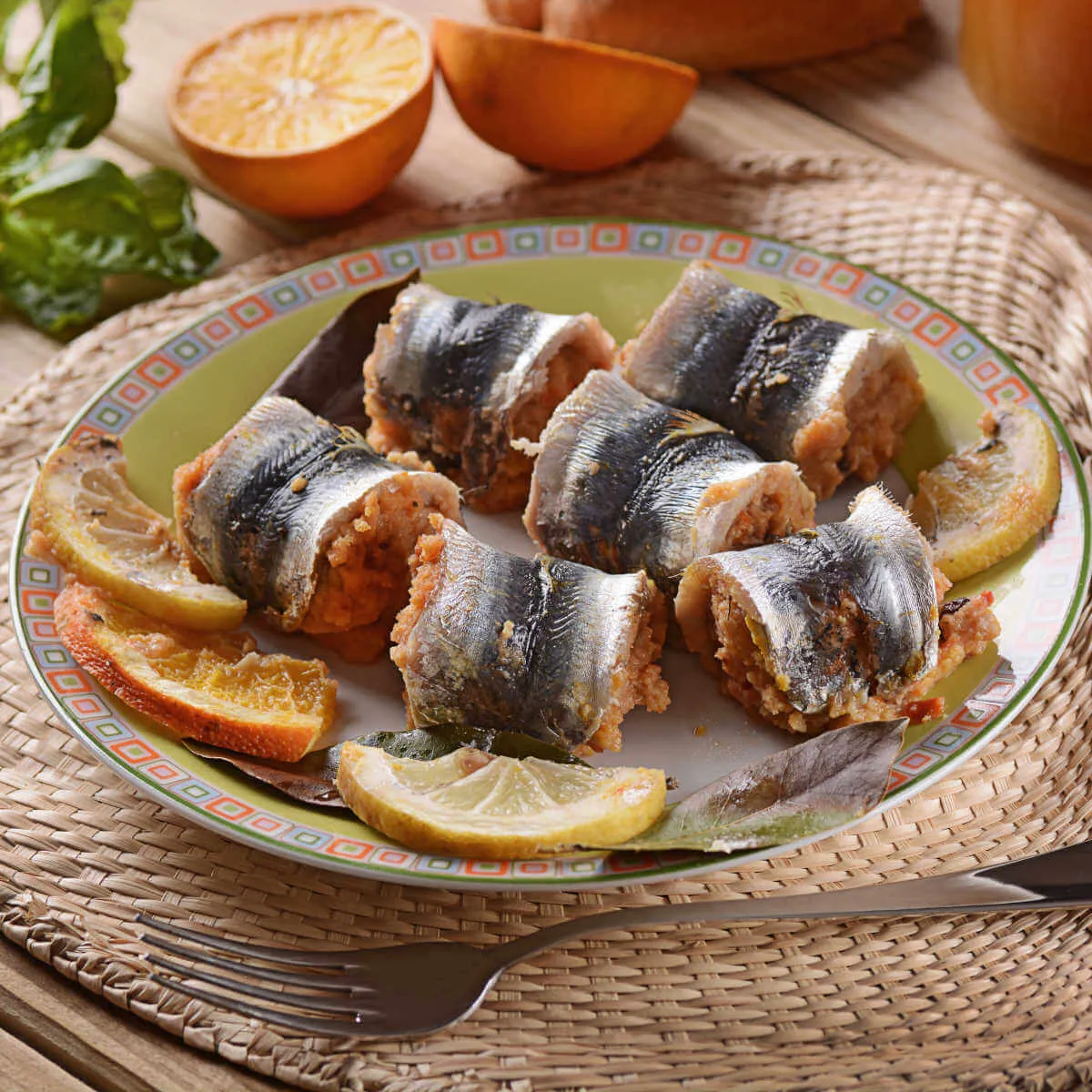
Sarde a Beccafico
Sarde a Beccafico is particularly well-known in Palermo. Simple sardines are cooked together with typical local ingredients from the island.
Once the sardines have been cleaned, they are opened like a book, ready to be stuffed. The traditional filling is a savoury mix of breadcrumbs, raisins, pine nuts, sugar, cocoa, herbs and spices like cinnamon and parsley, with a touch of lemon or orange juice. Some variations also include chopped anchovies or capers.
These rolls are then skewered and grilled or, more commonly today, baked. Before cooking, they are often sprinkled with additional breadcrumbs for extra crispiness.
As well as being delicious, this dish represents the very essence of Sicilian cuisine: the ability to transform simple and everyday ingredients into something extraordinary.
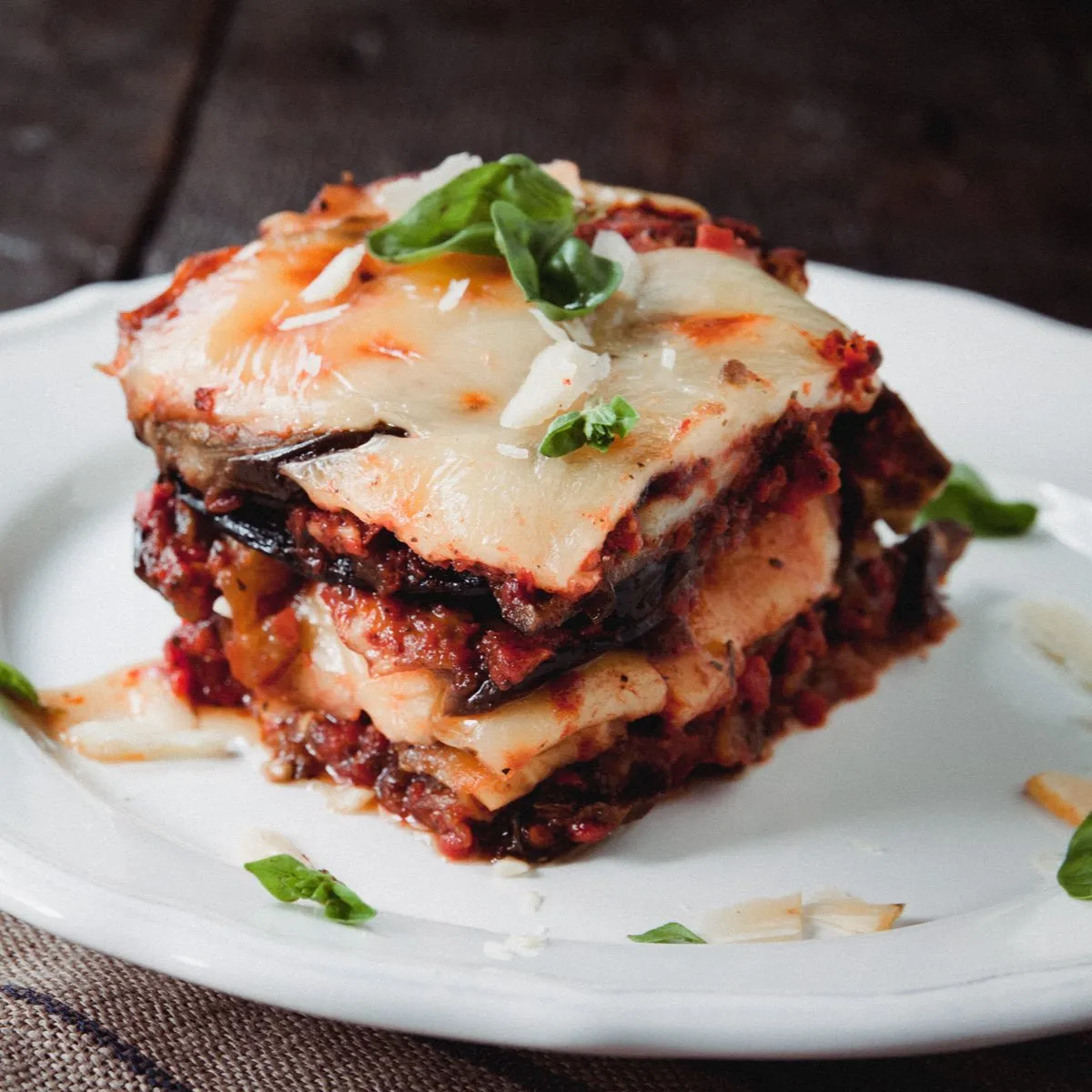
Parmigiana di Melanzane
Parmigiana di Melanzane is a well-known dish in Sicilian culinary tradition, a true icon that mixes intense flavours, history, and passion in the kitchen. Made of succulent layers of aubergine, tomato sauce, mozzarella, and grated cheese, this dish encapsulates the warm and welcoming soul of the island.
Aubergines are sliced, salted, and then left to rest to remove any bitterness and excess water. They are then fried until they are crispy on the outside but still tender inside.
After this, the layering begins: a base of tomato sauce, followed by fried aubergine slices, slices of mozzarella or caciocavallo, fresh basil leaves, more tomato sauce, and a generous sprinkling of grated cheese, usually Parmesan or pecorino. This process is repeated until the baking dish is full, and then the entire dish is baked until the surface becomes golden and crispy.
From the first bite, parmigiana di melanzane offers an extraordinary harmony of flavours and textures. The sweetness of the aubergine complements the richness of the tomato sauce, the melting flavour of mozzarella, and the savoury notes of grated cheese. The result is a comforting dish that immediately evokes the atmosphere of Sicilian festive tables.
Parmigiana di melanzane is perfect as a main course, but it can also be used as a starter or second course. In Sicily, it is often prepared on special occasions or holidays, or anytime when family gathers.
Unmissable Sicilian First Courses
First courses are perhaps one of the most authentic expressions of Sicily's rich and varied gastronomic tradition. These delicious dishes are primarily made with pasta, and each bite is a journey through the genuine and intense flavours of the island. This culinary experience reflects the simplicity and abundance of Sicilian tables, where recipes are passed down from generation to generation.
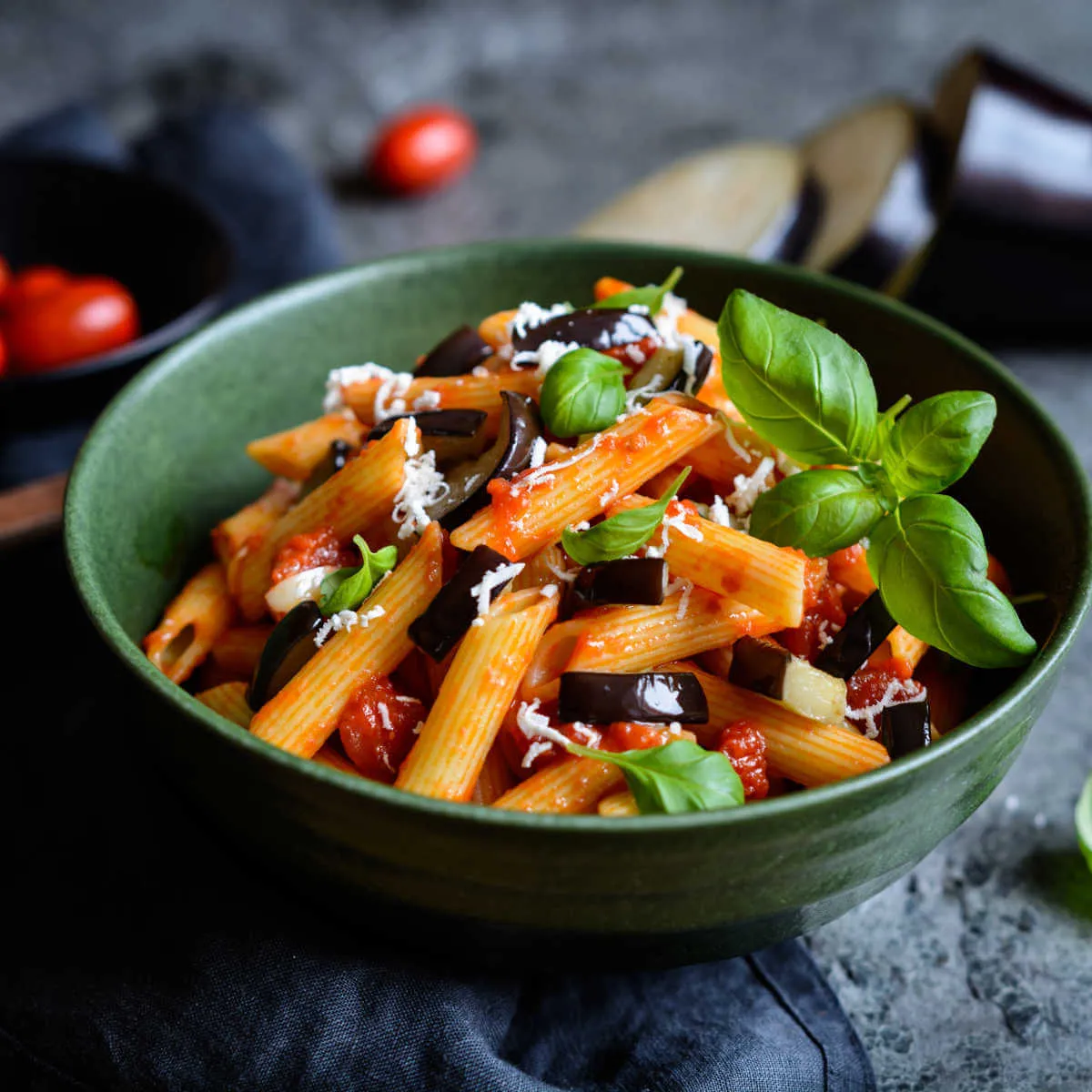
Pasta alla Norma
Pasta alla Norma is one of the stars in Sicilian culinary tradition, and is particularly famous in the city of Catania. This moreish pasta dish perfectly blends Mediterranean flavours.
The heart of this dish is aubergines. They are sliced or diced and then fried in olive oil until golden. Once fried, the aubergine is set aside, and a simple tomato sauce is prepared, flavoured with garlic and basil. The pasta is cooked al dente and then dressed with the sauce, and then the fried aubergine and a generous handful of grated ricotta salata – a typical Sicilian cheese with a bold, salty flavour – are added.
The combination of the sweetness of the aubergine with the tomato sauce and the savoury ricotta salata creates an unforgettable balance of flavours.
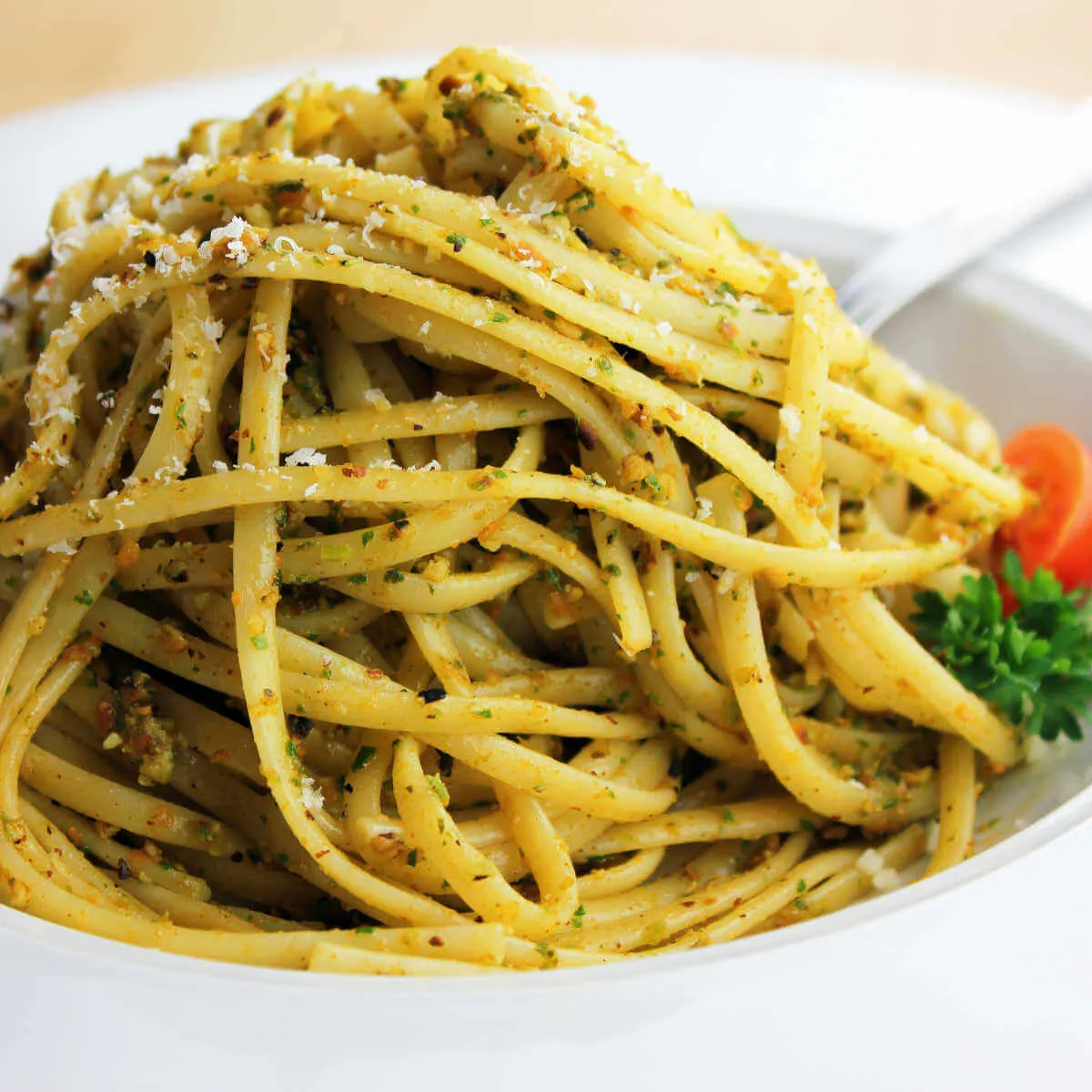
Busiate Trapanesi
Busiate Trapanesi are one of the symbols of the gastronomic tradition in the province of Trapani, in western Sicily. This particular pasta, with its twisted and sinuous shape, captivates not only the palate but also the eyes, telling stories of traditions and craftsmanship.
Busiate are traditionally handmade, using a simple mixture of durum wheat semolina and water. The absence of eggs makes this pasta particularly light.
The most famous sauce for busiate is "pesto alla trapanese" a Sicilian version of better-known Genovese pesto. Trapanese pesto is made of toasted almonds, fresh tomatoes, garlic, basil, and, of course, extra virgin olive oil. The result is a fresh, slightly granular, and incredibly aromatic sauce.
Enjoying a dish of busiate with Trapanese pesto is like taking a journey into the most authentic Sicily – the Sicily of countryside homes, family Sunday lunches, and village festivals.
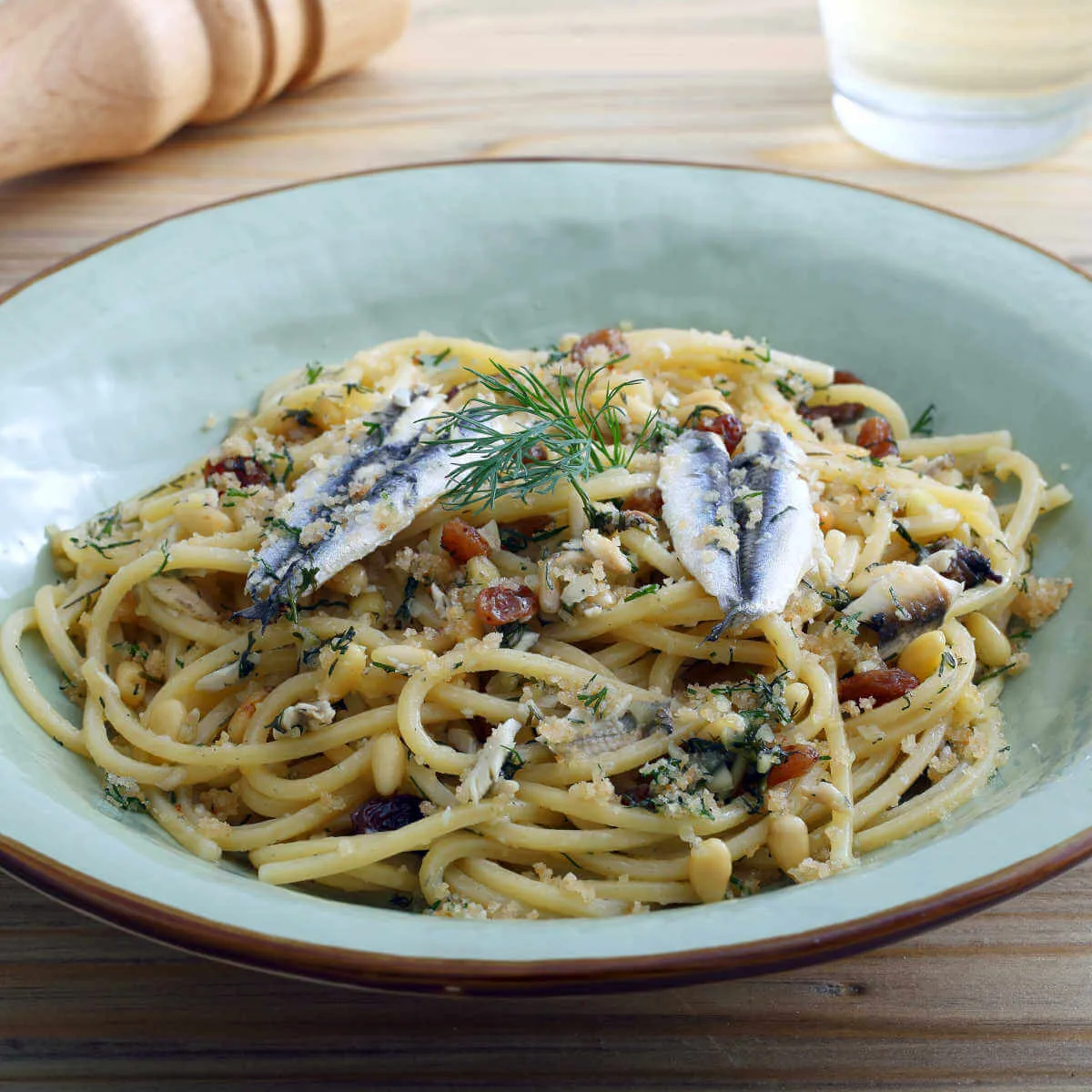
Pasta con le Sarde
Pasta con le Sarde is one of the most iconic and distinctive dishes of Sicilian cuisine – a perfect union of sea and land. Created in Palermo, this delicacy has retained its authenticity and timeless charm throughout the centuries.
The true star of this dish is the sardine, a small, flavourful fish abundant in Sicilian waters. To this, wild fennel is added, with its distinctive anise-like aroma. Wild fennel grows spontaneously in Sicily between February and April. These two main ingredients are combined with a sauce made from onions, anchovies, raisins, pine nuts, saffron, and sometimes black pepper or chili. The pasta used is usually spaghetti or linguine, but in some variations, you can find the more typical "bucatini corti."
What makes Pasta con le Sarde an unforgettable dish is the surprising balance: the bold flavour of the sardines contrasts with the sweetness of the raisins and the crunchiness of the pine nuts, whilst wild fennel adds freshness and depth to the dish.
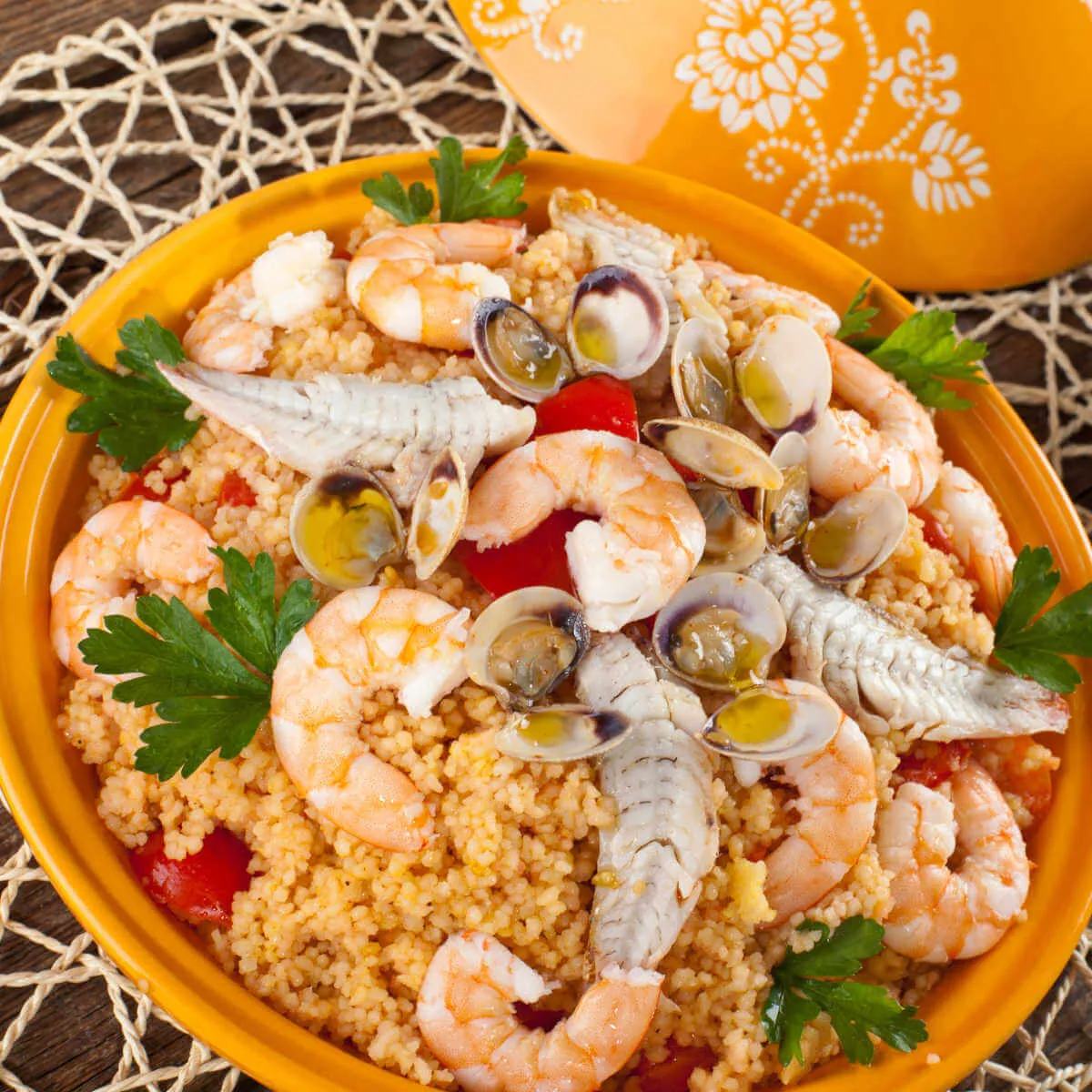
Cous Cous alla Trapanese
Cous Cous is one of the most authentic and surprising aspect of Sicilian cuisine. It is most famous in the province of Trapani. This dish is the perfect blend of culinary traditions from the Mediterranean and North Africa, demonstrating ancient ties and exchanges between the two shores of the sea.
Cous Cous alla Trapanese is distinguished by its rich fish-based broth. The fish used may vary, but often includes red scorpionfish, grouper, mullet, and sometimes shrimp or squid. The preparation process is meticulous and requires patience. Durum wheat semolina is steamed in special terracotta pots called "cuscussière", then carefully separated using fingers, and drizzled with olive oil.
Then, the rich and aromatic fish broth – often seasoned with ingredients such as onions, tomatoes, celery, parsley, and, in some variations, saffron – is poured over the cous cous. Cous Cous is not just a dish, but a ritual. Traditionally, it takes centre stage in celebrations and festivals, especially during the "Cous Cous Fest" in San Vito Lo Capo – an annual event celebrating this dish through culinary competitions and tastings.
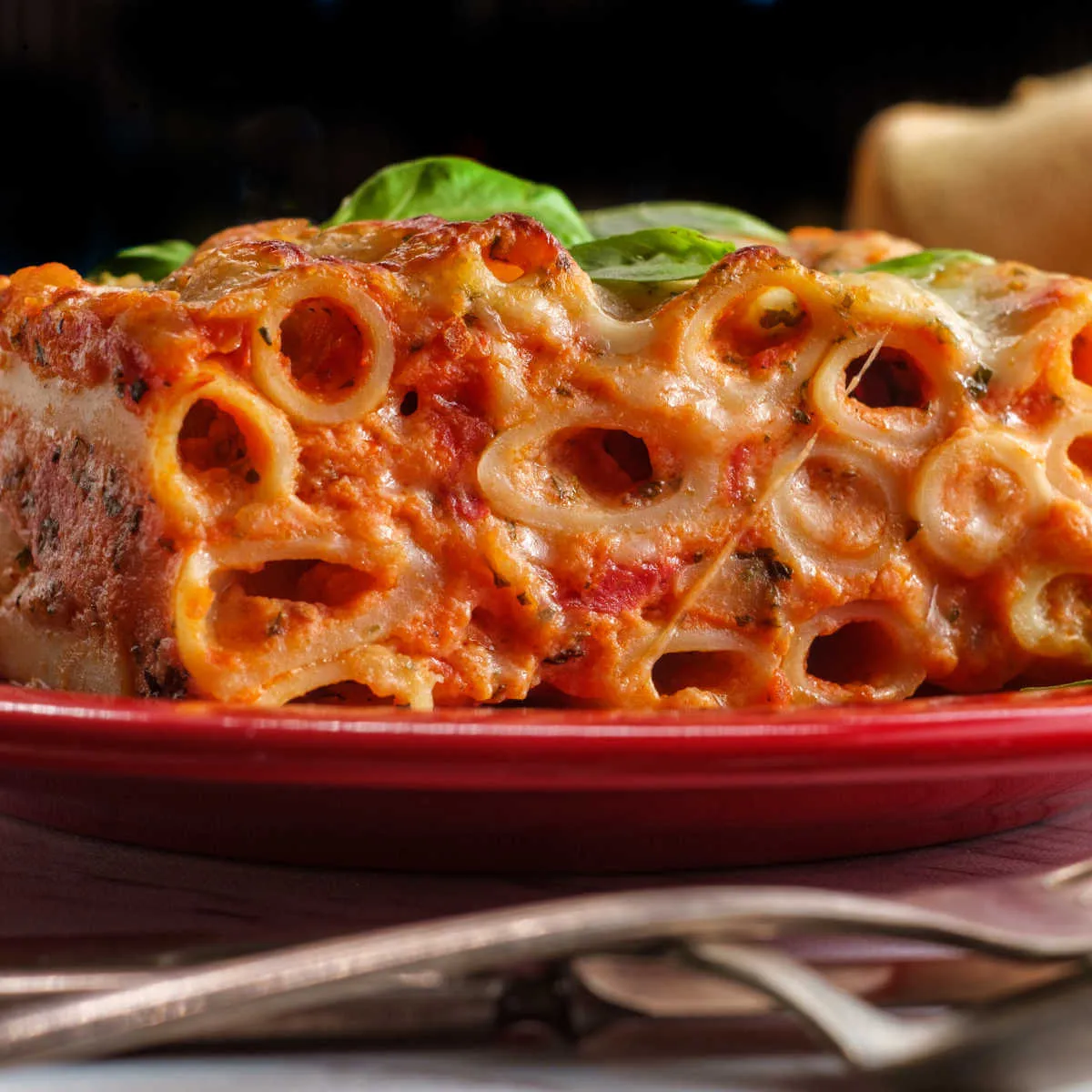
Sicilian Baked Pasta
Sicilian baked pasta is more than just a dish; it is a culinary celebration, a festival of flavours, colours, and tastes. It’s a journey through the history and traditions of a unique land.
Considered one of the quintessential Sunday and holiday dishes, it is a triumph of Sicilian gastronomic heritage, with recipes passed down from generation to generation.
Sicilian baked pasta stands out for its richness and complexity. The pasta, usually maccheroni or rigatoni, but in Palermo anelletti, is first boiled and then combined with a rich meat sauce (often a mix of pork and beef), enriched with peas, fried aubergine, and, in some versions, hard-boiled eggs. An unmistakable and essential ingredient is provola – a typical Sicilian cheese – which adds a wonderful creaminess. Another element that elevates the dish is the presence of small meatballs scattered among the layers of pasta.
The ingredients should be layered in a baking dish, alternating pasta with sauce, cheese, and meatballs. The entire dish is then covered with a generous sprinkling of grated pecorino before being baked until the surface becomes golden and bubbling.
Sicilian baked pasta is an ode to tradition. It’s a dish that encapsulates the warm and welcoming soul of Sicily: rich, varied, surprising, and, above all, delicious.
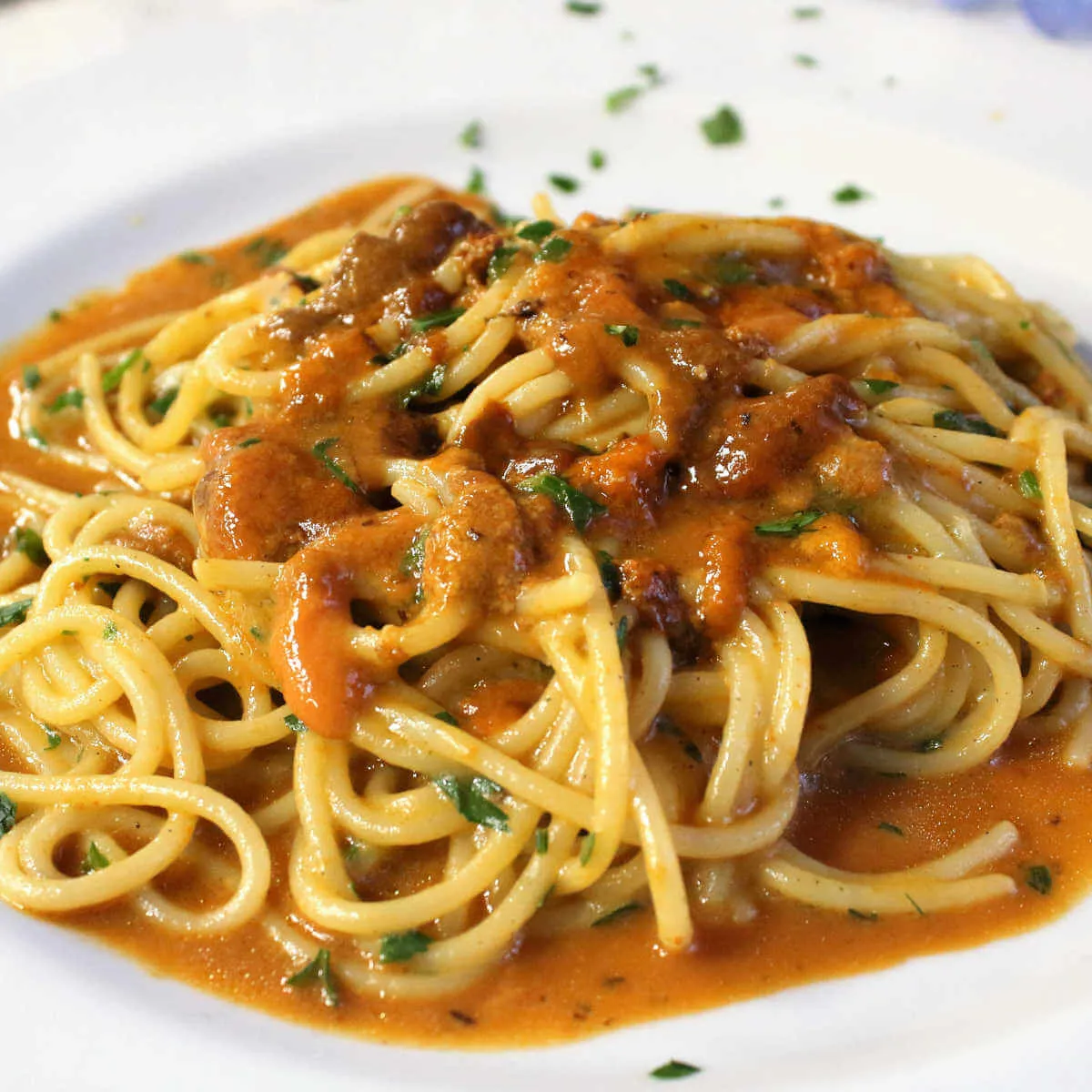
Spaghetti ai Ricci di Mare
Spaghetti ai Ricci di Mare represents one of the most precious culinary gems of Sicilian and Mediterranean cuisine. This dish captures the essence of the sea, transporting those who taste it directly to the sunny shores of Sicily.
Sea urchins, with their spiky appearance but tender and tasty insides, have always had a place of honour in Sicilian cuisine. The simplicity of the ingredients and the quick preparation of Spaghetti ai Ricci di Mare make it a highly appreciated dish, often associated with summer memories and seaside gatherings.
The dish is simple but requires very fresh ingredients. After boiling the spaghetti al dente, garlic is quickly sautéed with extra virgin olive oil. Once the garlic is golden, fresh sea urchins are added, allowing them to infuse for a few minutes. The spaghetti is then added to this mixture, and sometimes a pinch of chili is added to give the dish a lively touch.
The taste of sea urchins is unique: slightly sweet, with a salty note that brings to mind the sea. The contrast between the pasta and the creaminess of the sea urchins creates a perfect balance of flavours and textures.
If you want to recreate these delicacies yourself, take a look at our experiences for food enthusiasts.
Typical Sicilian Fish Dishes
Sicily, with its coasts bathed by the Mediterranean Sea, has a seafood culinary tradition that reflects its geographical position and history. Sicilian cuisine has transformed seafood into true gastronomic masterpieces, combining simple ingredients with cooking techniques that enhance the natural flavours of local fish products.
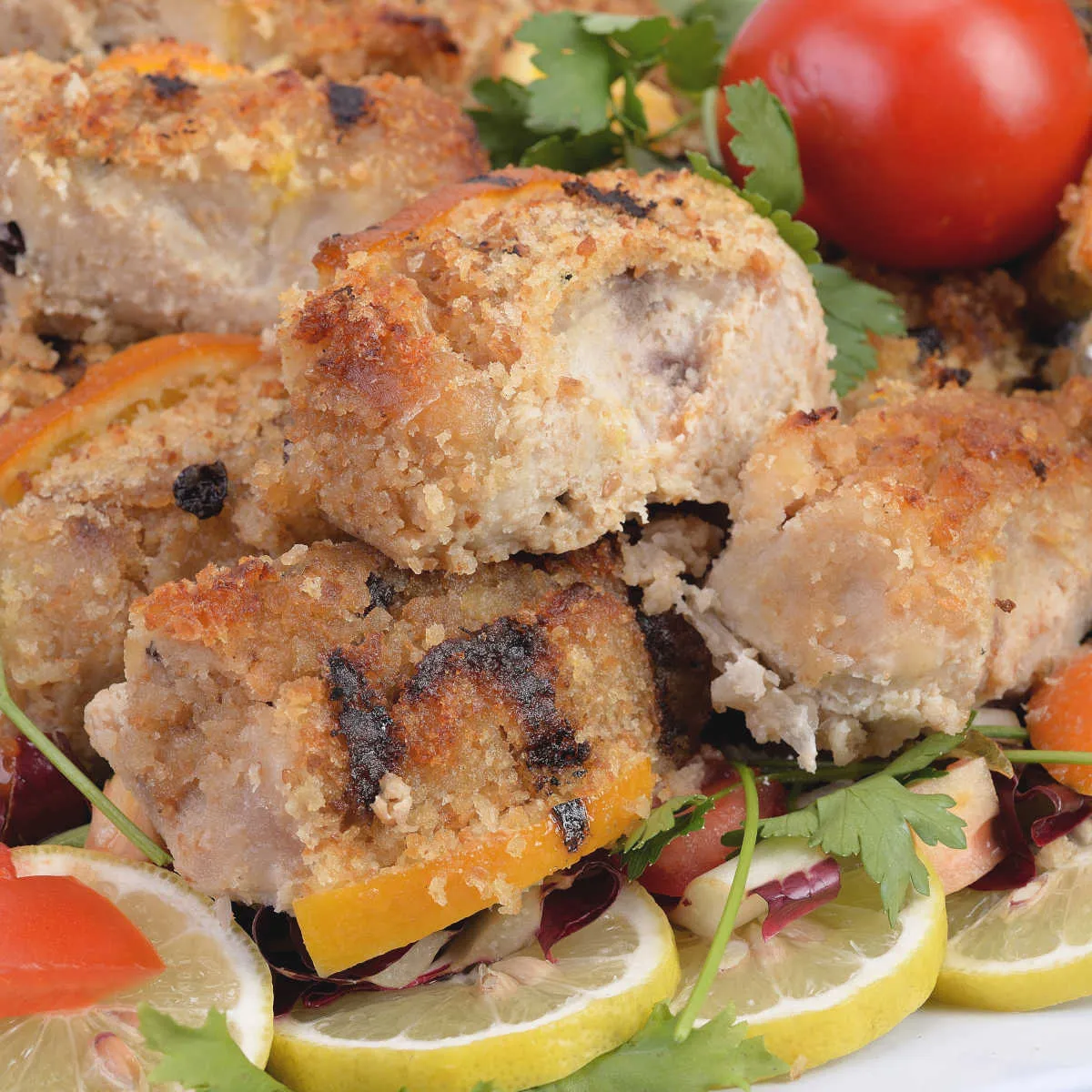
Swordfish Rolls
Swordfish rolls are one of the most appreciated delicacies in Sicilian cuisine. This dish embodies the traditions of an island surrounded by the crystal-clear waters of the Mediterranean.
The preparation of swordfish rolls begins with thin slices of fish, cut crosswise. These slices are then filled with a mixture of breadcrumbs, pine nuts, raisins, parsley, garlic, pepper, and a pinch of salt. Once rolled up and secured with a toothpick, the slices are briefly seared in a pan with olive oil until they become golden. Some variations include the addition of fresh tomatoes and capers, contributing an extra touch of freshness to the dish.
The aromatic, crunchy filling goes perfectly with the swordfish. The sweetness of the raisins and the crunchiness of the pine nuts harmoniously combine with the delicious fish, creating a truly unique balance of tastes.
Swordfish rolls are often prepared on special occasions and during holidays, and they have become one of the undisputed protagonists of Sicilian tables.
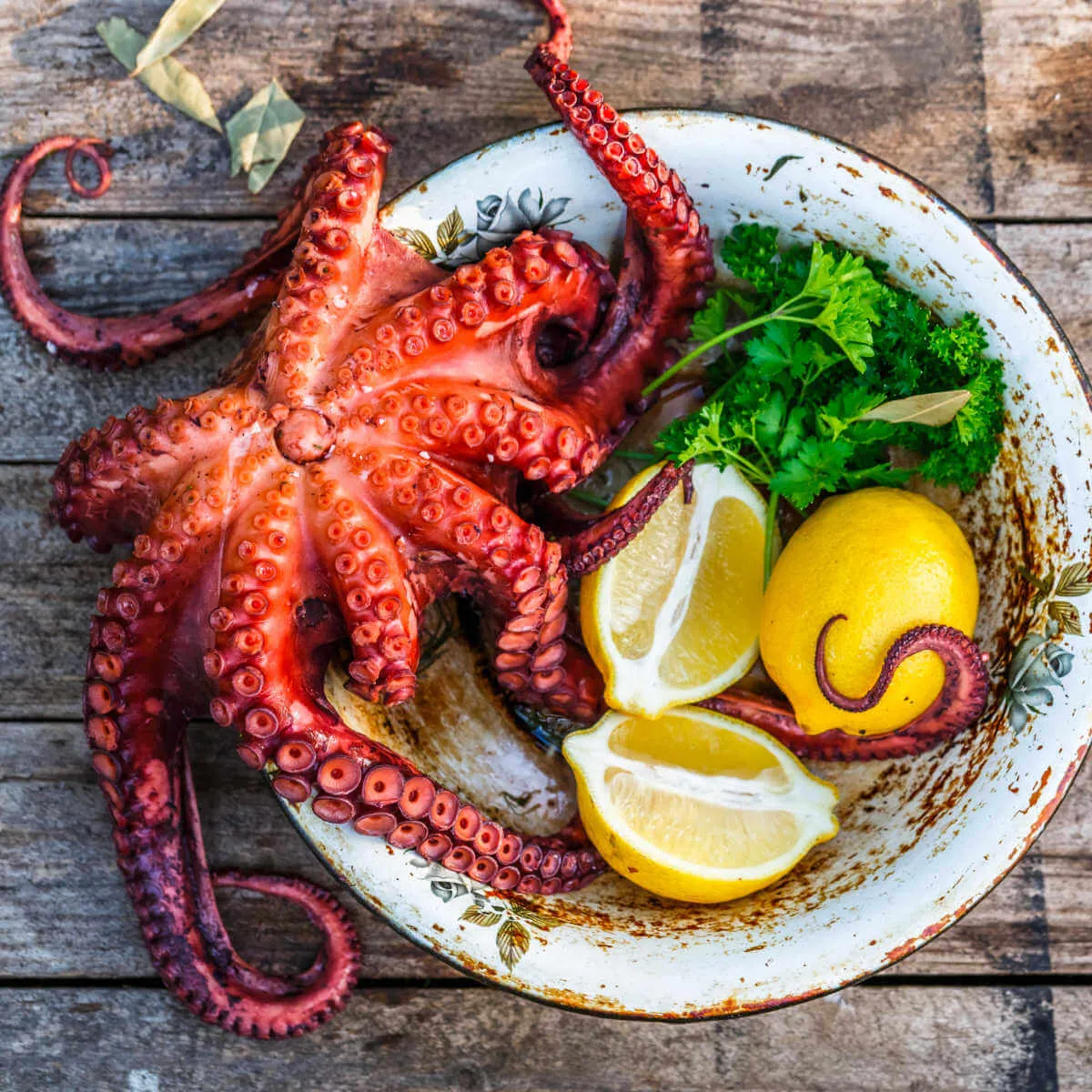
Boiled or Grilled Octopus
Octopus is one of the most beloved and versatile ingredients in Sicilian cuisine. Its presence in the waters around the island has led to the development of a series of traditional dishes where this mollusc takes centre stage.
One of the most classic recipes is "Boiled Octopus": the mollusc is immersed in cold water with bay leaves, salt, and lemon. Once it begins to boil, it is cooked for about 40-45 minutes. The octopus is then cut into pieces and seasoned with olive oil, salt, pepper, and parsley, and is often accompanied by potato salad.
Another beloved variant is "Grilled Octopus": after boiling, the octopus is grilled. The result is a crispy grilled exterior and a soft interior, a true taste of the sea.
Each bite brings together the passion and artistry of Sicilian cuisine, offering an authentic and unforgettable gastronomic experience. If there is a way to dive into the beating heart of Sicily through food, octopus is undoubtedly one of the best ways to do so.
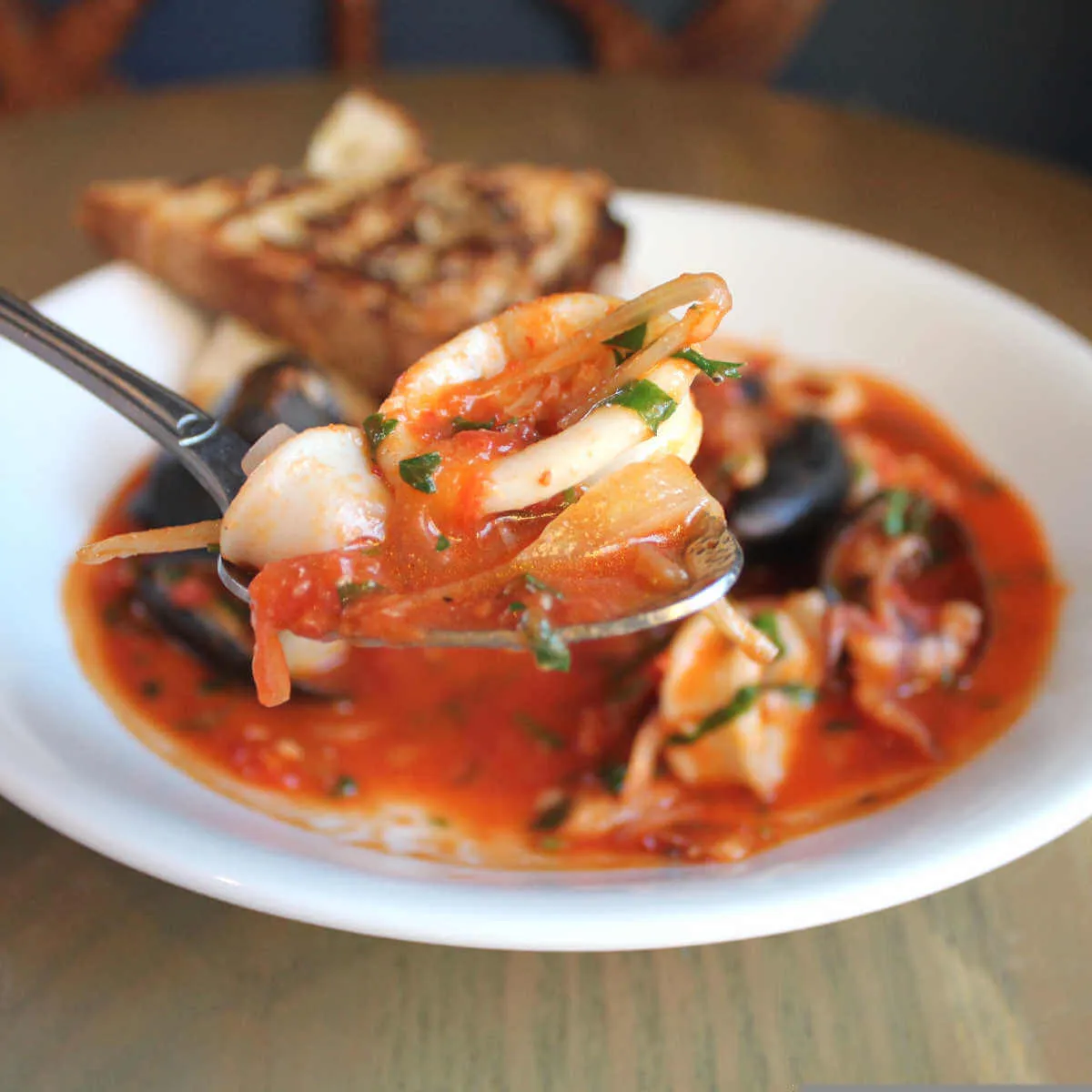
Sicilian Fish Soup
Sicilian fish soup shows the deep connection between Sicily and its sea. This recipe, like delicate ink on canvas, paints the picture of an island where culinary tradition meets the generosity of the Mediterranean.
Sicilian fish soup is a symphony of flavours. The base of the soup is made by sautéed garlic, onion, fresh tomatoes, and a generous splash of white wine. To this aromatic mix, various types of fish are added, often depending on availability and the season. Scorpionfish, mullet, squid, shrimp, mussels, and clams are just some of the protagonists that can be part of this delicious soup.
What makes Sicilian fish soup so special is its authenticity. Each ingredient maintains its distinctive flavour, but when combined, they create a symphony of tastes. Often, this soup is served with toasted slices of homemade bread or poured over pasta like spaghetti or linguine, turning the dish into a substantial first course.
Eating Sicilian fish soup is an experience that goes beyond food; it is a warm embrace from the island and its invaluable culinary heritage.
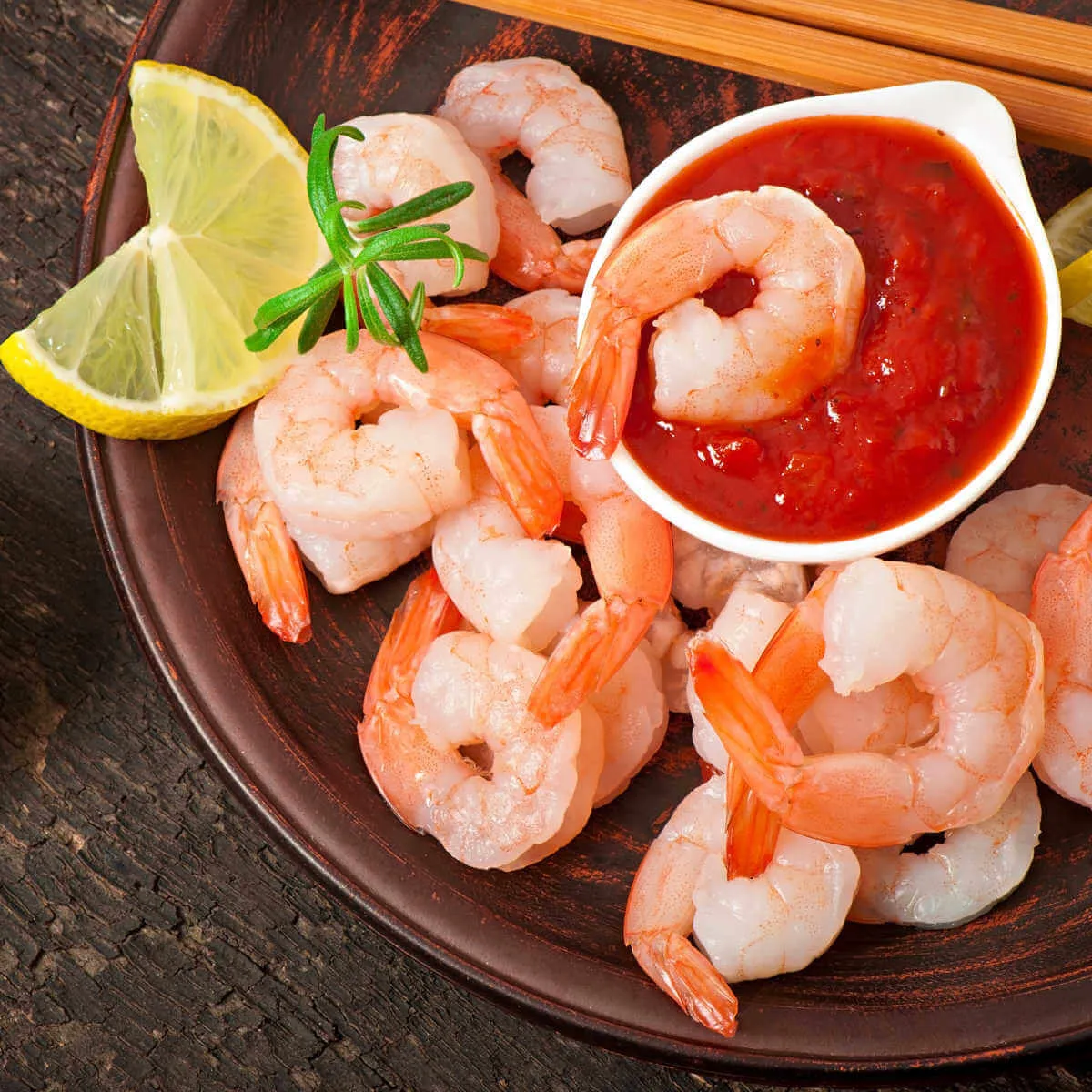
Red Prawns
The Sicilian red prawn – a true delicacy of the Mediterranean – is one of the most prized symbols of the island's cuisine. With its intense colour and unmistakable flavour, this crustacean has won over palates around the world, making every dish in which it is present a unique gastronomic experience.
The Sicilian red prawn stands out for its bright colour, ranging from deep pink to ruby red. Its flesh is very tender and has a sweet and delicate taste, with a slightly briny aftertaste that evokes the scent of the sea.
The Sicilian red prawn is often enjoyed raw, simply dressed with a drizzle of extra virgin olive oil and a few drops of lemon to enhance its natural flavour. However, it also lends itself to more elaborate dishes: it can be the star of risottos, pasta dishes, carpaccios, or can even be the main ingredient in any seafood dish, cooked in a pan, in the oven, or on the grill.
Sicilian Sweets to Absolutely Try
We conclude our journey into the typical flavours of Sicily with a glimpse into the island's unique and inimitable pastry tradition. The presence of ingredients such as almonds, citrus fruits, honey, and ricotta gives rise to dishes where flavours, scents, and colours come together to create an explosion of pleasure for both the eyes and the palate. Let's explore some of the most iconic Sicilian sweets that must be tried during your stay on the island, perhaps by preparing them yourself during one of our cooking experiences.

Sicilian Cannoli
The word "cannolo", in Sicilian "cannolu", literally means "small tube." This sweet treat is undoubtedly one of the most recognisable and beloved symbols of Sicilian pastry.
The cannoli are made of two main elements:
The shell - a thin dough made of flour, wine, sugar, and cocoa, wrapped around a metal tube ("canna") and fried until it becomes crispy and golden. Once cooled, the shell maintains its typical tubular shape.
The filling - a rich and delicious cream made from sheep's milk ricotta, sweetened and flavoured with vanilla or orange zest, often with dark chocolate chips or candied fruit.
While the traditional recipe is sacred to many Sicilians, variations do exist. Some add candied fruit or orange zest to the filling, while others decorate the ends with chopped pistachios. In some versions, a dusting of bitter cocoa or powdered sugar can also be found.
One thing is certain in any case: cannoli, with their perfect balance between outer crispiness and inner creaminess, are the very essence of Sicilian pastry tradition.
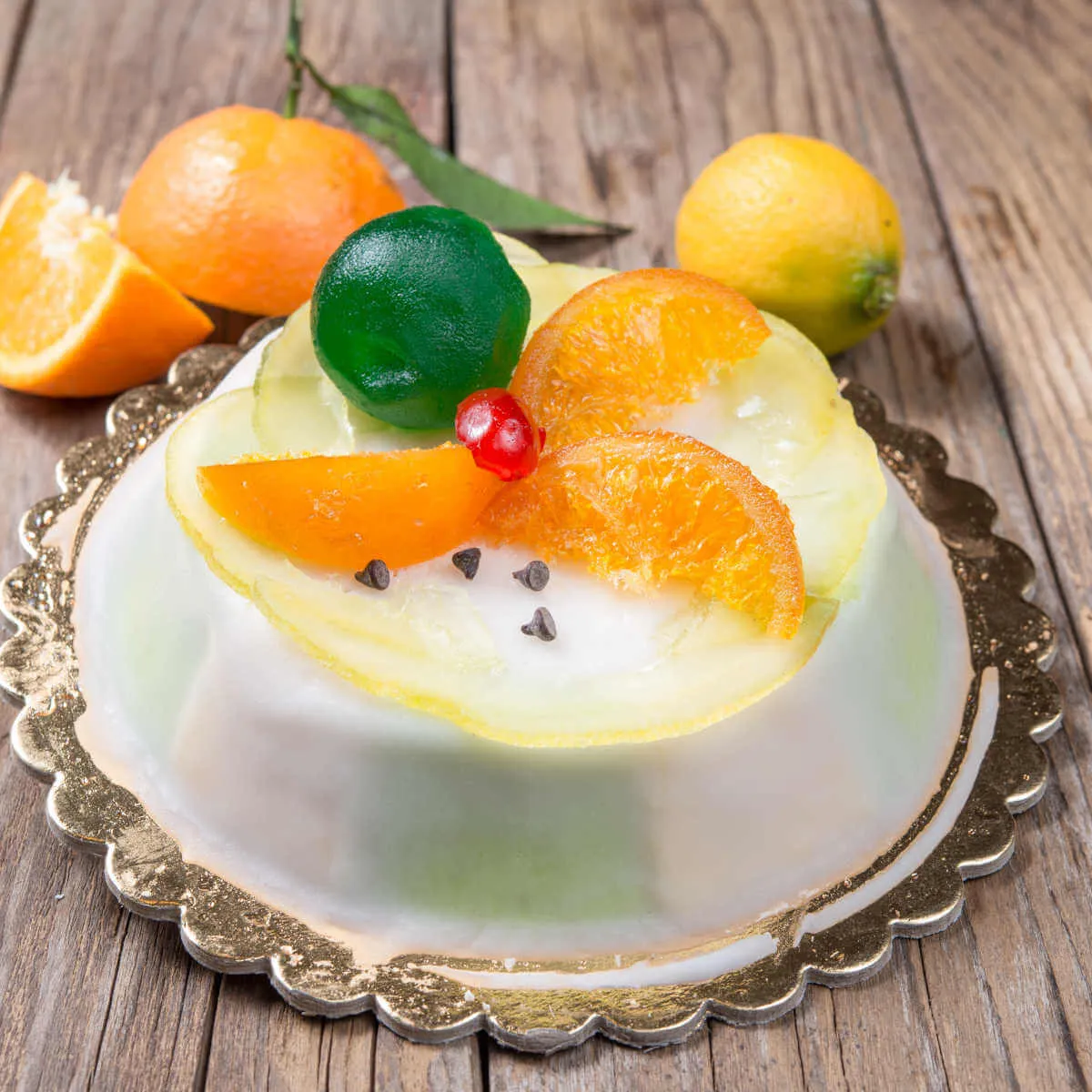
Sicilian Cassata
Sicilian cassata is a traditional cake which, like cannoli, is one of the most well-known and appreciated symbols of Sicilian pastry. It is a rich and sumptuous dessert that encapsulates centuries of history and cultural influences.
Cassata is a celebration of flavours and textures. It consists of several layers and ingredients:
Sponge cake - thin disks that form the base and sides of the dessert.
Ricotta - a generous layer of sweetened sheep's milk ricotta, enriched with dark chocolate pieces or chocolate chips.
Candied fruit - colourful pieces of cherries, melon, or citrus, preserved in sugar, decorate the surface of the cassata.
Marzipan or Pasta Reale - a sugared almond paste that covers the cassata, giving it a smooth and shiny appearance.
Glaze - a thin sugar glaze covers the marzipan, providing brightness and flavour.
Each element of cassata has its own story. The candied fruit represents Arab influence, while the chocolate in the ricotta filling reflects Spanish domination and their trade with the New World. Marzipan, on the other hand, is a testament to local traditions linked to almond cultivation.
Sicilian cassata is not just a simple and common cake. It is the embodiment of Sicily in a sweet form: enjoying a slice of cassata, with its contrasts between sweet and bitter, soft and crunchy, is an experience that every dessert-lover should have at least once in their life.
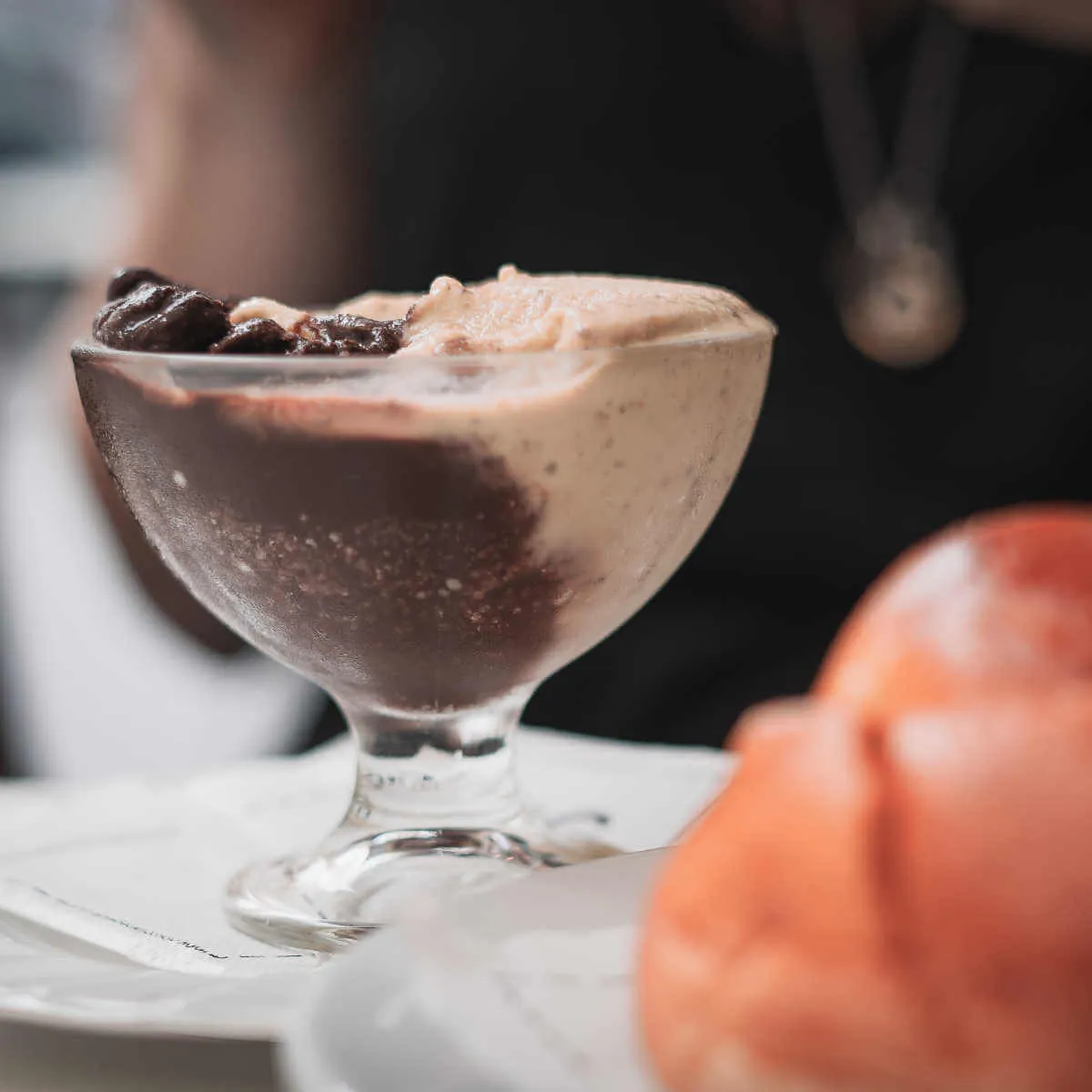
Brioche with Gelato
In a land where the sun shines intensely for much of the year, and flavours are intense and generous, brioche with gelato is one of the most loved breakfasts and snacks, not only by Sicilians but also by anyone visiting this enchanting island.
Different from the classic French brioche, the Sicilian one has a particular shape, often called "tuppo" because it resembles a small chignon. Soft, slightly sweet, and with a tender heart, it is the perfect surrounding for a scoop of gelato.
Creamy, rich, and often prepared with fresh and local ingredients such as Bronte pistachios, almonds, Sicilian citrus, or Modica chocolate, gelato is the perfect ingredient to accompany the brioche.
Although it may seem like a heavy dessert, brioche with gelato is traditionally consumed for breakfast, especially during hot summer mornings. However, it is also a popular choice for an afternoon snack. Along the streets of Sicily, especially in ice cream shops and bars, it is not uncommon to see both locals and tourists enjoying this speciality, perhaps strolling or sitting in a square, making the most of the slow and indulgent rhythm of the island.
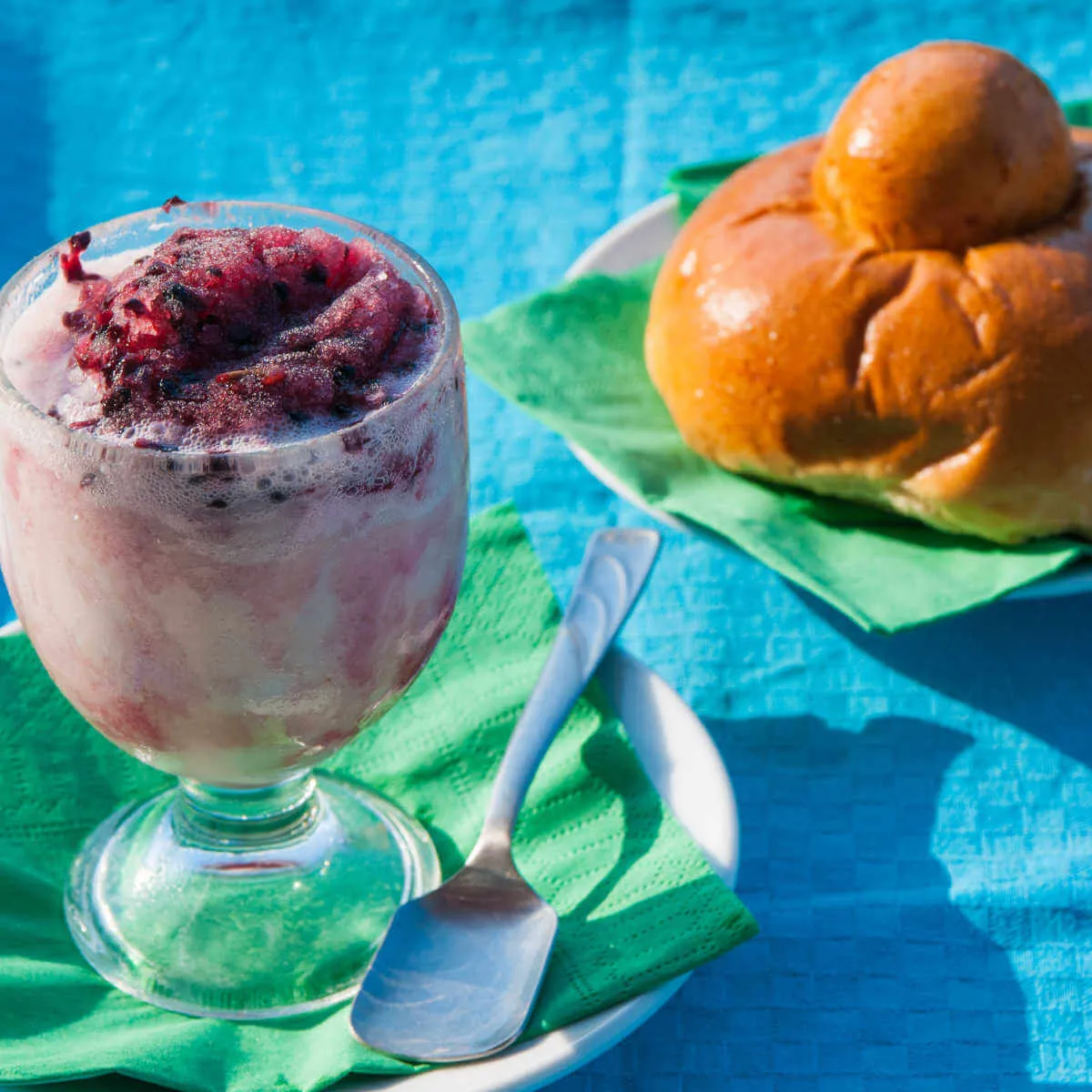
Sicilian Granita
In a land kissed by the sun and enveloped in the scents of the Mediterranean, Sicilian granita emerges as an oasis of freshness and sweetness, and is a symbol of summer on the island.
Unlike other forms of shaved ice or sorbets, Sicilian granita has a unique, crystalline, and velvety texture. It is made with water, sugar, and natural ingredients such as fresh fruit, almonds, or coffee. The mixture is frozen slowly, and it is scraped and stirred regularly to prevent a solid block forming and to ensure its well-known consistency. Among the most popular flavours are lemon, almond, coffee, island fruits, and pistachio.
Granita is traditionally served for breakfast, accompanied by a "brioche col tuppo". But it is also appreciated as a refreshing snack during a hot summer day or as dessert after a meal. In Sicily, granita is not just a dessert; it is a moment of coming together, a childhood memory, an unforgettable summer ritual.
As we reach the end of this wonderful culinary journey, all that remains is to recommend the best food experiences selected by Villatravellers for food enthusiasts staying in Sicily: cooking classes, tastings, and guided tours.






































































